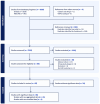Exploring associations between estrogen and gene candidates identified by coronary artery disease genome-wide association studies
- PMID: 40182431
- PMCID: PMC11965610
- DOI: 10.3389/fcvm.2025.1502985
Exploring associations between estrogen and gene candidates identified by coronary artery disease genome-wide association studies
Abstract
Introduction: Coronary artery disease (CAD) is the leading cause of death around the world, with epidemiological sex and gender differences in prevalence, pathophysiology and outcomes. It has been hypothesized that sex steroids, like estrogen, may contribute to these sex differences. There is a relatively large genetic component to developing CAD, with heritability estimates ranging between 40%-60%. In the last two decades, genome-wide association studies (GWAS) have contributed substantially to advancing the understanding of genetic candidates contributing to CAD. The aim of this study was to determine if genes discovered in CAD GWASs are affected by estrogen via direct modulation or indirect down-stream targets.
Methods: A scoping review was conducted using MEDLINE and EMBASE for studies of atherosclerotic coronary artery disease and a genome-wide association study (GWAS) design. Analysis was limited to candidate genes with corresponding single nucleotide polymorphisms (SNPs) surpassing genome-wide significance and had been mapped to genes by study authors. The number of studies that conducted sex-stratified analyses with significant genes were quantified. A literature search of the final gene lists was done to examine any evidence suggesting estrogen may modulate the genes and/or gene products.
Results: There were 60 eligible CAD GWASs meeting inclusion criteria for data extraction. Of these 60, only 36 had genome-wide significant SNPs reported, and only 3 of these had significant SNPs from sex-stratified analyses mapped to genes. From these 36 studies, a total of 61 genes were curated, of which 26 genes (43%) were found to have modulation by estrogen. All 26 were discovered in studies that adjusted for sex. 12/26 genes were also discovered in studies that conducted sex-stratified analyses. 12/26 genes were classified as having a role in lipid synthesis, metabolism and/or lipoprotein mechanisms, while 11/26 were classified as having a role in vascular integrity, and 3/26 were classified as having a role in thrombosis.
Discussion: This study provides further evidence of the relationship between estrogen, genetic risk and the development of CAD. More sex-stratified research will need to be conducted to further characterize estrogen's relation to sex differences in the pathology and progression of CAD.
Keywords: coronary artery disease; estrogen; gene candidates; genome wide association study; sex differences.
© 2025 Aminbakhsh, Théberge, Burden, Adejumo, Gravely, Lehman and Sedlak.
Conflict of interest statement
The authors declare that there are no commercial or financial relationships that could be perceived as a potential conflict of interest.
Figures






Similar articles
-
Identification of 26 novel loci that confer susceptibility to early-onset coronary artery disease in a Japanese population.Biomed Rep. 2018 Nov;9(5):383-404. doi: 10.3892/br.2018.1152. Epub 2018 Sep 17. Biomed Rep. 2018. PMID: 30402224 Free PMC article.
-
Contribution of Gene Regulatory Networks to Heritability of Coronary Artery Disease.J Am Coll Cardiol. 2019 Jun 18;73(23):2946-2957. doi: 10.1016/j.jacc.2019.03.520. J Am Coll Cardiol. 2019. PMID: 31196451 Free PMC article.
-
Genome-Wide Association Studies and Risk Scores for Coronary Artery Disease: Sex Biases.Adv Exp Med Biol. 2018;1065:627-642. doi: 10.1007/978-3-319-77932-4_38. Adv Exp Med Biol. 2018. PMID: 30051411 Review.
-
Genome-Wide European Ancestry Study Identifies Coronary Artery Disease-Associated Loci Through Gene-Sex Hormone Interaction.J Am Heart Assoc. 2024 Dec 17;13(24):e034132. doi: 10.1161/JAHA.123.034132. Epub 2024 Dec 14. J Am Heart Assoc. 2024. PMID: 39673284 Free PMC article.
-
Genome-wide association studies on coronary artery disease: A systematic review and implications for populations of different ancestries.PLoS One. 2023 Nov 29;18(11):e0294341. doi: 10.1371/journal.pone.0294341. eCollection 2023. PLoS One. 2023. PMID: 38019802 Free PMC article.
Cited by
-
A nomogram for predicting the risk of coronary artery disease in premenopausal women with suspected coronary artery disease.Sci Rep. 2025 Aug 11;15(1):29410. doi: 10.1038/s41598-025-14589-6. Sci Rep. 2025. PMID: 40790067 Free PMC article.
References
-
- Stark B, Johnson C, Roth GA. Global prevalence of coronary artery disease: an update from the global burden of disease study. J Am Coll Cardiol. (2024) 83(13_Supplement):2320–2320. 10.1016/S0735-1097(24)04310-9 - DOI
-
- Pacheco C, Mullen KA, Coutinho T, Jaffer S, Parry M, Van Spall HGC, et al. The Canadian women’s heart health alliance atlas on the epidemiology, diagnosis, and management of cardiovascular disease in women—chapter 5: sex- and gender-unique manifestations of cardiovascular disease. CJC Open. (2022) 4(3):243–62. 10.1016/j.cjco.2021.11.006 - DOI - PMC - PubMed
Publication types
LinkOut - more resources
Full Text Sources
Miscellaneous

